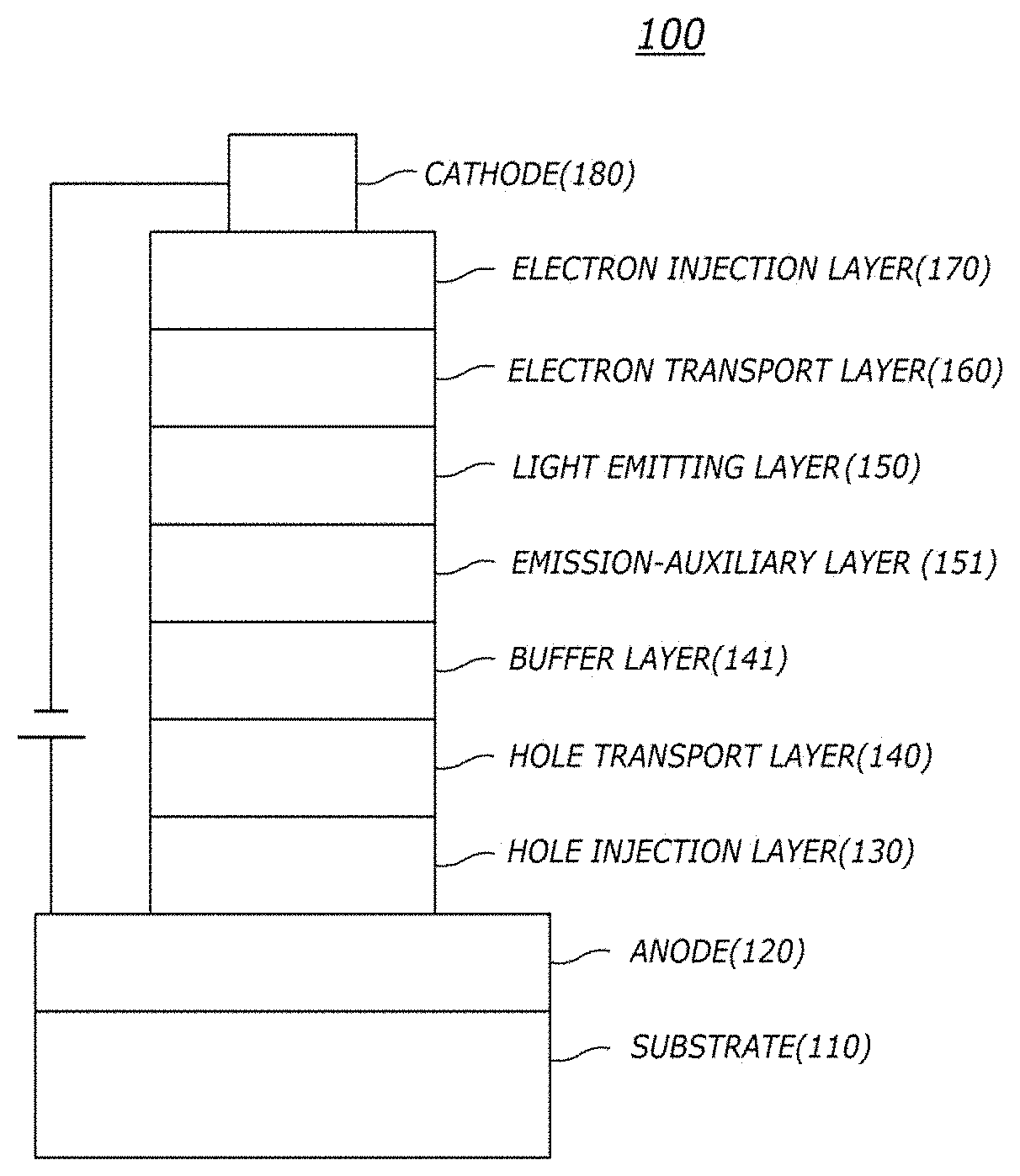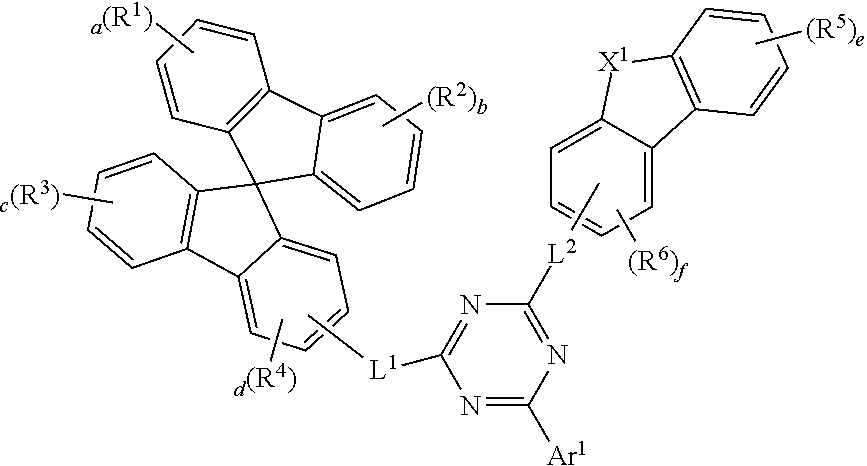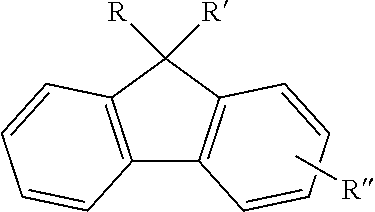Compound for organic electronic element, organic electronic element comprising the same, and electronic device thereof
a technology of electronic elements and organic electric elements, which is applied in the field of organic electric elements, organic electric elements comprising the same, and electronic devices thereof, can solve the problems of reducing the efficiency of corresponding elements, reducing the luminous efficiency, and shifting the maximum luminescence wavelength to a longer wavelength, so as to improve the luminous efficiency and lifetime of elements, the effect of lowering the driving voltage and reducing the driving voltag
- Summary
- Abstract
- Description
- Claims
- Application Information
AI Technical Summary
Benefits of technology
Problems solved by technology
Method used
Image
Examples
synthesis example
of Sub 1
[0055]Sub 1 of the Reaction Scheme 1 may be synthesized by the reaction route of the following Reaction Scheme 2, but there is no limitation thereto.
Synthesis Example of Sub 1(a-1)
[0056]
Synthesis Example of Sub 1-3-a-1
[0057]After putting Sub 1-1-a-1 (41.4 g, 115 mmol) and Sub 1-2-a-1 (32.4 g, 115 mmol), NaOH (9.2 g, 230 mmol), Pd(PPh3)4 (6.6 g, 5.75 mmol) into a round bottom flask, THF (800 mL) and water (200 mL) were added thereto and the mixture was dissolved. Then, the solution was refluxed at 80° C. for 12 hours. When the reaction was completed, the reaction product was cooled to room temperature, extracted with CH2Cl2 and washed with water. The organic layer was dried with MgSO4 and concentrated. The concentrate was separated through a silica gel column to obtain Sub 1-3-a-1(36 g, 66%).
Synthesis Example of Sub 1(a-1)
[0058]After Sub 1-3-a-1 (36.3 g, 76.4 mmol) was dissolved in THF (700 mL), the temperature of the reactant was lowered to −78° C., n-BuLi (36.7 mL, 2.5M in ...
example of sub 1
[0092]The example compounds of Sub 1 may be, but not limited to, the following compounds, and Table 1 shows the FD-MS values of the following compounds.
TABLE 1CompoundFD-MSSub 1(a-1)m / z = 436.16(C31H22BO2 = 437.16)Sub 1(a-6)m / z = 436.16(C31H22BO2 = 437.16)Sub 1(a-9)m / z = 436.16(C31H22BO2 = 437.16)Sub 1(a-13)m / z = 436.16(C31H22BO2 = 437.16)Sub 1(a-17)m / z = 436.16(C31H22BO2 = 437.16)Sub 1(a-21)m / z = 436.16(C31H22BO2 = 437.16)Sub 1(a-25)m / z = 436.16(C31H22BO2 = 437.16)Sub 1(a-29)m / z = 436.16(C31H22BO2 = 437.16)Sub 1(a-33)m / z = 436.16(C31H22BO2 = 437.16)Sub 1(a-37)m / z = 436.16(C31H22BO2 = 437.16)Sub 1(a-41)m / z = 436.16(C31H22BO2 = 437.16)Sub 1(a-45)m / z = 436.16(C31H22BO2 = 437.16)
example of sub 2
[0093]Example of Sub 2 may be, but not limited to, the following compounds, and Table 2 shows the FD-MS values of the following compounds.
TABLE 2CompoundFD-MSSub 2(c-1)m / z = 357.07(C21H12ClN3O = 358.07)Sub 2(c-2)m / z = 357.07(C21H12ClN3O = 358.07)Sub 2(c-3)m / z = 357.07(C21H12ClN3O = 358.07)Sub 2(c-4)m / z = 357.07(C21H12ClN3O = 358.07)Sub 2(c-49)m / z = 373.04(C21H12ClN3O = 374.04)Sub 2(c-50)m / z = 373.04(C21H12ClN3O = 374.04)Sub 2(c-51)m / z = 373.04(C21H12ClN3O = 374.04)Sub 2(c-52)m / z = 373.04(C21H12ClN3O = 374.04)Sub 2(c-93)m / z = 432.11(C27H17ClN4 = 433.11)Sub 2(c-94)m / z = 432.11(C27H17ClN4 = 433.11)Sub 2(d-99)m / z = 433.10(C27H16ClN3O = 434.10)Sub 2(d-100)m / z = 433.10(C27H16ClN3O = 434.10)Sub 2(d-193)m / z = 449.08(C27H16ClN3S = 450.08)Sub 2(d-194)m / z = 449.08(C27H16ClN3S = 450.08)Sub 2(d-195)m / z = 449.08(C27H16ClN3S = 450.08)Sub 2(d-196)m / z = 449.08(C27H16ClN3S = 450.08)Sub 2(d-241)m / z = 449.08(C27H16ClN3S = 450.08)Sub 2(d-242)m / z = 449.08(C27H16ClN3S = 450.08)Sub 2(d-243)m / z = 449.08(C27...
PUM
| Property | Measurement | Unit |
|---|---|---|
| thickness | aaaaa | aaaaa |
| thickness | aaaaa | aaaaa |
| thickness | aaaaa | aaaaa |
Abstract
Description
Claims
Application Information
 Login to View More
Login to View More - R&D
- Intellectual Property
- Life Sciences
- Materials
- Tech Scout
- Unparalleled Data Quality
- Higher Quality Content
- 60% Fewer Hallucinations
Browse by: Latest US Patents, China's latest patents, Technical Efficacy Thesaurus, Application Domain, Technology Topic, Popular Technical Reports.
© 2025 PatSnap. All rights reserved.Legal|Privacy policy|Modern Slavery Act Transparency Statement|Sitemap|About US| Contact US: help@patsnap.com



